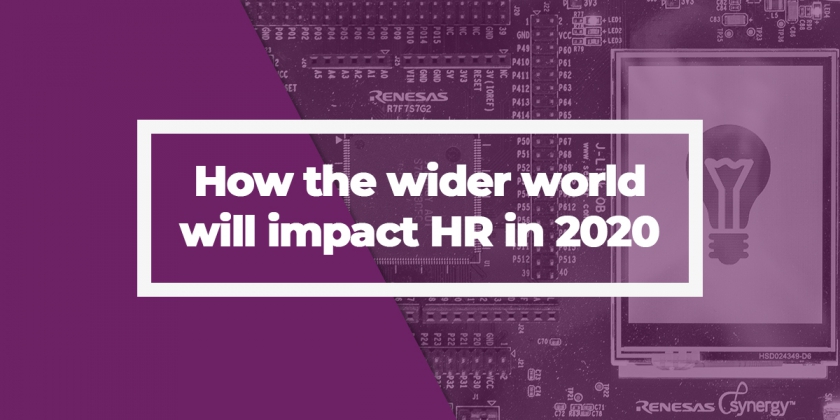How the political, technological and economic landscape might influence the world of HR in 2020
Whilst many things are uncertain as the world eases into 2020, one thing is an undeniable certainty: this year will be one of the most exciting, scary and challenging years we have seen in a while. Brexit is obviously one of the key changes that may affect the employment landscape everywhere in Europe, as some speculate that certain segments of the UK workforce will move away.
But other elements such as the changing laws around what constitutes self-employment in the new global gig economy, particularly brought to the media’s attention by Uber’s fight to keep its drivers classified as independent, could also have significant impacts. Both for the contractors and their employers.
So what should we expect in 2020 in terms of HR trends and how can companies globally prepare ahead of time?
1) Be kind: the humanisation of the organisation
Businesses are slowly realising that the tables have turned. The focus isn’t so much on trying to please the boss, but on attracting and retaining great talent. Many organisations are therefore focussing on employee-centric initiatives addressing issues such as the gender pay gap, health and wellbeing and diversity in the workplace. Whilst this isn’t new, the benchmark is changing. It isn’t merely about having internal guidelines anymore. The soft approach isn’t enough and more aggressive action is required. Policies such as shared parental leave that support men wishing to play a more active role in child-rearing and allow women more choice and flexibility, as seen in the Nordic countries, could become an important factor for employees when selecting career options.
Increased focus on diversity and
inclusion or managers tackling mental health will also start to become difficult
to avoid, with topics previously stigmatised coming up to the surface. If your
company doesn’t have ways to support menopausal women in the workplace or tools
to help deal with stress and anxiety, this could be a good place to start. Many
businesses are now creating their own staff wellness guides, including advice
on coping with stress and preventing burn-out, and incorporate those in
processes such as onboarding and induction. Some will go further, offering
unlimited health days, in-house massages during stressful periods and even
helping to improve staff’s physical health. The University of Indiana recently
partnered with Fitbit to roll out a comprehensive wellness programme aimed at
reducing staff obesity and chronic diseases using wearable tech[1].
2) Flexibility as a cost-saving exercise
You may have already heard it: 9 to 5 is dead, long live flexible remote working. This is of course influenced by the modern digital lifestyle adopted by so many. But remote working isn’t just for the beany-wearing trendy millennials working in shared offices in front of their latte macchiato. It is also a key tool in helping parents return to work, offering increased flexibility to support women in the workplace. And as the talent war rages on, finding great local employees can be a difficult task. Remote working allows employers to find the right fit within their teams, whether those team members are based nearby on in a completely different country.
In addition, the cash-strapped SMEs and start-ups group is developing new processes to encourage remote working as a cost-saving measure to reduce overheads. So as time goes by, you may discover that most organisations simply no longer have the space to accommodate everyone in their office and that remote teams will become even more remote, with several time zones to consider at once.
3) Technology as an HR tool
We are not quite at the stage where AI will automate your yearly performance reviews. But the HR industry has greatly benefited from the arrival of new technologies in the past couple of years and the trend is here to stay. With increased competition for talent, organisations cannot afford to get it wrong and need the data in place to better identify and manage talent internally. Employee analytics allow for less biased decisions based on set KPIs and data-driven performance management. Companies such as Dubai-based transportation network Careem use technology to regularly collect engagement scores from employees, allowing for continuous performance management as a great example of technology supporting career development.
Automating some less interesting tasks is also a way to free up HR time and focus staff on what truly matters. Chatbots for example are a great way to answer simple queries that would otherwise clog up staff’s to do list. Other tools include online platforms allowing for peer-to-peer recognition, regular feedback or satisfaction data. The key is to keep it simple. Regular easy-to-fill surveys will allow you to measure the pulse of your organisation and take corrective action much more efficiently than the usual more cumbersome, comprehensive data gathering tools we’re used to. So whilst some of those key trends are already at our doorsteps, presenting businesses globally with opportunities to take immediate action and get going towards becoming a great place to work, the future is indeed excitingly uncertain. We are going through some unprecedented events and other unexpected opportunities may arise along the way, changing the employment landscape and presenting proactive companies everywhere with new challenges to take on. So whilst we all wait in anticipation to see the impact of Brexit, the new laws around self-employment and many more political and economic initiatives, one thing is certain: by focussing on being a flexible, employee-centric and technology-focussed employer, you can’t really go wrong. And we’ll be here to regularly update you on future trends as we see them arise.
[1] HR Technologist, 27th August 2019, last visited 6th January 2020.
